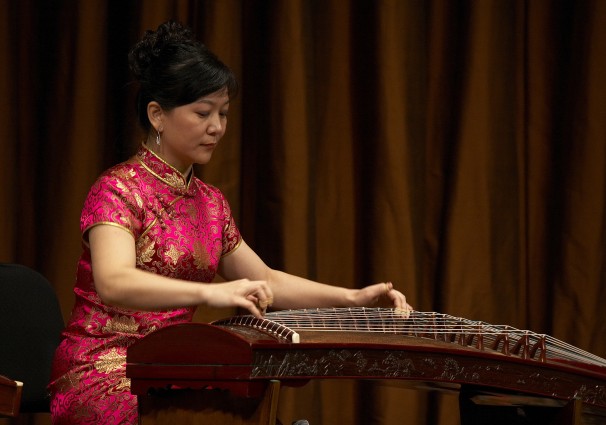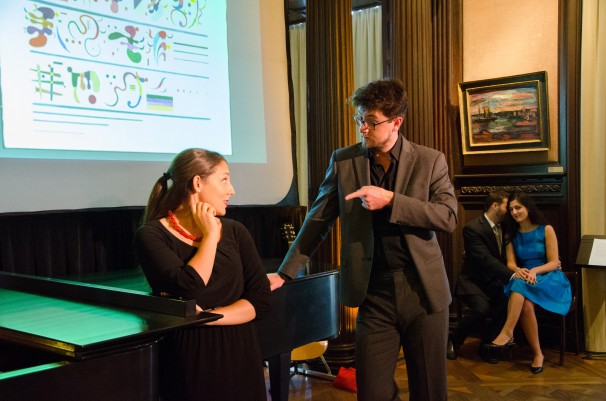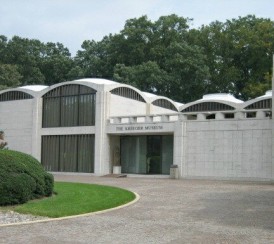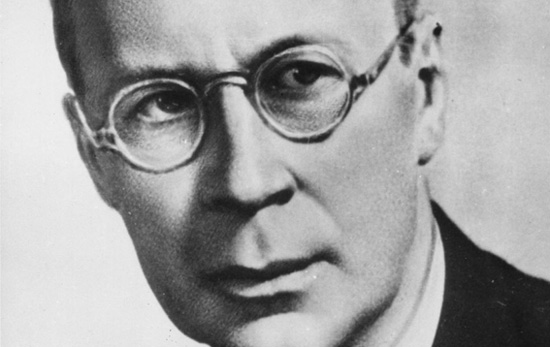Guzheng music at the Sackler Gallery
By Stephen Brookes • The Washington Post • July 30, 2013
Recitals of music for the guzheng — the ancient 21-stringed Chinese zither — are not exactly staples of the Washington concert scene. So it was a rare treat when Bing Xia and Rujia Teng, two virtuosos of this extraordinary instrument, arrived at the Smithsonian’s Sackler Gallery this past weekend for a series of performances of music inspired by the mythical phoenix. Bing XiaThe phoenix — a bird that famously burned to death and was reborn from its own ashes — has been a powerful symbol in Chinese art for centuries, and the program mixed ancient folk songs and traditional music with very contemporary works, all of the music impressionistic and often highly programmatic. “The Phoenix Soars,” for example, evoked a bird in effortless flight, while the colorful “A Hundred Birds Worship the Phoenixes” resonated with pitch-perfect bird calls. Perhaps the most beautiful work on the program — a modern piece by Huan Liu titled “Phoenixes Flying Together” — created a sense of floating weightlessly over a vast landscape, the gentle rise and fall of the melodic lines like the slow beating of wings.
Bing XiaThe phoenix — a bird that famously burned to death and was reborn from its own ashes — has been a powerful symbol in Chinese art for centuries, and the program mixed ancient folk songs and traditional music with very contemporary works, all of the music impressionistic and often highly programmatic. “The Phoenix Soars,” for example, evoked a bird in effortless flight, while the colorful “A Hundred Birds Worship the Phoenixes” resonated with pitch-perfect bird calls. Perhaps the most beautiful work on the program — a modern piece by Huan Liu titled “Phoenixes Flying Together” — created a sense of floating weightlessly over a vast landscape, the gentle rise and fall of the melodic lines like the slow beating of wings.
The almost orchestral range of sonic color that the two players drew from their instruments — bent notes, harplike swirls, percussive effects and so on — was little short of breathtaking, and both delivered precise, deeply felt performances, despite the distractions of playing in an open art gallery rather than a quiet concert hall. Bing Xia, the director of the Washington Guzheng Society, displayed her virtuosity in “The Phoenix Pursues His Mate,” managing its intricate finger-work with ease. Her gifted student Rujia Teng, though still only 17, proved to be an accomplished young virtuoso in her own right, turning in a poetic and absolutely riveting account of “Nirvana of the Phoenixes,” a modern work by Deyuan Zheng.
Vocal Colors at the Phillips Collection
By Stephen Brookes • The Washington Post • July 26, 2013
By midsummer, the classical music scene in Washington is usually deep in the doldrums, nodding along sleepily until the superstars return to Strathmore and the Kennedy Center in the fall. But it’s a great time to catch young, up-and-coming performers — particularly those in the Wolf Trap Opera Company’s annual summer residency program, four of whom were showcased Thursday evening in a very personal, deftly sung and relentlessly charming concert at the Phillips Collection.
 The evening — titled “Vocal Colors” — ranged from show tunes to serious lieder, and paired music chosen by the singers themselves with artwork from the Phillips. Soprano Andrea Carroll and mezzo-soprano Maya Lahyani (both of whom starred in Wolf Trap’s production of Rossini’s “The Journey to Reims” last month) got things off to a strong start with the “Barcarolle” duo from Offenbach’s “Tales of Hoffmann,” showing off rich and supple voices as well as a subtle sense of drama.
The evening — titled “Vocal Colors” — ranged from show tunes to serious lieder, and paired music chosen by the singers themselves with artwork from the Phillips. Soprano Andrea Carroll and mezzo-soprano Maya Lahyani (both of whom starred in Wolf Trap’s production of Rossini’s “The Journey to Reims” last month) got things off to a strong start with the “Barcarolle” duo from Offenbach’s “Tales of Hoffmann,” showing off rich and supple voices as well as a subtle sense of drama.
Those qualities marked both women’s singing all evening. Carroll — a native of Bethesda — has a warm, confident voice that brought out the delicately shaded hues of Debussy’s “C’est l’extase,” as well as the more physical punchiness of “Troubled Woman” by Ricky Ian Gordon. She brought power and insight to both works.
Lahyani’s gorgeous mezzo voice was delicately balanced between anguish and nostalgia in Rachmaninoff’s “Do Not Sing for Me,” and her account of “Forgiveness” by the Israeli composer Oded Lerer — a beautiful piece in moody colors — was as lyrical as it was sensuous, delivered with quiet and convincing passion.
The men didn’t fare quite as well. Benjamin Bliss has a wonderfully clear and light, but not particularly rich, tenor voice and kept things entertaining with an arrangement of the Appalachian folk tune “The Old Woman’s Courtship” and Paul Simon’s “The Boxer,” on which he accompanied himself on the guitar. Baritone Steven LaBrie pulled out the stops for Agustin Lara’s heart-on-sleeve “Humo en los ojos,” but it came out so over-emoted that it might have worked better if he’d left a few stops in. He has a fine voice, though, and his lower-key reading of Howard Wells’s “Everyone Sang” was genuinely moving.
The real climax of the evening was Stephen Sondheim’s “You’re Gonna Love Tomorrow” (from “Follies”), which brought all four singers together for an upbeat close to the concert — music perfect for lifting the summer doldrums. Josephine Riggs provided fine accompaniment on the piano, as she did all evening.
Mendelssohn Piano Trio at the National Gallery of Art
By Stephen Brookes • The Washington Post • July 1, 2013
Take some sweeping passion and a bit of soaring ecstasy, add a dash of heart-rending despair, season with heaving breasts and sighing melodies, then mix it all together with impeccable elegance and taste — that’s Romantic-era music at its best, and the National Gallery of Art was awash in the stuff Sunday night, when the fine young Mendelssohn Piano Trio presented a program so lush, substantial and richly flavored you wanted to eat it with a knife and fork.
Given the ensemble’s name, you’d expect Mendelssohn himself to be front and center on the program, and his Piano Trio No. 2 in C Minor, Op. 66 made a strong opening to the evening. The work, from 1845, is quintessential Mendelssohn — roiling with emotion, but always firmly in control of itself — and that’s exactly how the Mendelssohn players approached it. They’re a wonderfully diverse group: The hard-charging Taiwanese pianist Ya-Ting Chang brought muscle to the music, while violinist Peter Sirotin — a native of Ukraine — displayed a precise and slightly cool professionalism, and English cellist Fiona Thompson anchored the music with quiet assurance. That made for an engaging performance, technically immaculate and often very eloquent, with a finely calibrated sense of dramatic flow. You never sensed that they were really tearing open a vein — there was little of the white-hot intensity and wild passion that make Romantic-era music burst fully to life — but it was a warm and deeply felt performance nonetheless, and beautifully played.
It was a fine idea to pair the inward-looking Mendelssohn piece with Tchaikovsky’s more epic — even symphonic — Piano Trio in A Minor, Op. 50, which took up the second half of the evening. Tchaikovsky apparently hated the sound of these three instruments together (he called it “torture”), but you’d never know it from this 1882 work, which opens with a brooding “Pezzo elegiaco” and closes with a spectacular set of variations, all written in memory of his friend Nikolai Rubinstein. The trio gave it a thoughtful reading, rich in psychological insight, that drew together the threads of nostalgia, celebration, tenderness and regret that weave through the music, like a tapestry of delicate and already-fading memories.
Carpe Diem Quartet at the National Gallery of Art
By Stephen Brookes • The Washington Post • June 24, 2013
It’s not hard to design a crowd-pleasing string quartet recital. You open with Haydn, toss in a little Mendelssohn or Brahms (maybe Debussy, if you’re daring), build up to one of the heftier Beethoven quartets and call it a day. It’s far more difficult to find fresh, pathbreaking new works that show how vibrant the quartet form still is — and that leave audiences on their feet and shouting for more.
 Jonathan LeshnoffBut that’s exactly what the aptly named Carpe Diem String Quartet did on Sunday night, in an adventurous and often breathtaking recital of modern music at the National Gallery of Art’s West Garden Court. Eclectic almost to a fault, the group ranged from jazz to Turkish dances to some of the hardest-hitting music of the 20th century, and built to a spectacular climax with the premiere of a quartet by composer Jonathan Leshnoff that was nothing less than exalting — a major addition to the string quartet repertoire.
Jonathan LeshnoffBut that’s exactly what the aptly named Carpe Diem String Quartet did on Sunday night, in an adventurous and often breathtaking recital of modern music at the National Gallery of Art’s West Garden Court. Eclectic almost to a fault, the group ranged from jazz to Turkish dances to some of the hardest-hitting music of the 20th century, and built to a spectacular climax with the premiere of a quartet by composer Jonathan Leshnoff that was nothing less than exalting — a major addition to the string quartet repertoire.
The program opened and closed with some likable arrangements of the jazz standards “Take Five” and “Blue Rondo a la Turk,” but far more exciting was a suite of five new dances by Erberk Eryilmaz. “Miniatures Set No. 4” is a swirling, dervish-like explosion of a work, full of Turkish folk rhythms and bluesy bent notes and sudden yelps and shouts from the players. The excitement continued with Bela Bartok’s equally volatile Fifth String Quartet from 1934, whose landscapes of slashing chords and windswept wildness were brought off with white-hot intensity. Korine FujiwaraThe quartet’s violist, Korine Fujiwara, is a composer as well, and her 2010 work “Hands” proved an enjoyable and smile-filled work, awash in soaring melodies, snapping fingers and inventive ideas. But it was Leshnoff’s String Quartet No. 4 that was the real event of the evening. From a base of modest musical motives (inspired, in part, by a recorder recital at his daughter’s school), the quartet built with seamless logic into a vast, thoroughly beautiful and extraordinarily moving work, its juggernaut-like power balanced with a luminous, almost hymn-like sense of spirituality and grace. It is a masterpiece any way you look at it, and the Carpe Diem players — for whom the work was written — played it with the absolute commitment it deserved.
Korine FujiwaraThe quartet’s violist, Korine Fujiwara, is a composer as well, and her 2010 work “Hands” proved an enjoyable and smile-filled work, awash in soaring melodies, snapping fingers and inventive ideas. But it was Leshnoff’s String Quartet No. 4 that was the real event of the evening. From a base of modest musical motives (inspired, in part, by a recorder recital at his daughter’s school), the quartet built with seamless logic into a vast, thoroughly beautiful and extraordinarily moving work, its juggernaut-like power balanced with a luminous, almost hymn-like sense of spirituality and grace. It is a masterpiece any way you look at it, and the Carpe Diem players — for whom the work was written — played it with the absolute commitment it deserved.
Newspeak at the Atlas Performing Arts Center
By Stephen Brookes • The Washington Post • June 23, 2013
In the tiny but essential niche of punk-classical music, Newspeak pretty much rules. Driving rhythms, sophisticated compositions by cutting-edge composers, virtuosic playing on electrified instruments — there’s little not to like about the New York-based ensemble, and after canceling a show here last fall because of Hurricane Sandy, Newspeak arrived at the Atlas Performing Arts Center on Friday night for a set steeped in rock, politics and a kind of nostalgia for the revolutionary violence of the 1960s.
 Frederick RzewskiThe evening, billed as an exploration of “imprisonment and release,” made for an often hard-punching close to the Atlas’s New Music series. Things lurched into gear as the ensemble tackled composer Corey Dargel’s “Last Words From Texas,” a song cycle built on the final statements of eight criminals as they were led to their executions. That’s a compelling idea — what goes through the human mind in those intense, final moments? But the disappointing answer, it turns out, is: not much.
Frederick RzewskiThe evening, billed as an exploration of “imprisonment and release,” made for an often hard-punching close to the Atlas’s New Music series. Things lurched into gear as the ensemble tackled composer Corey Dargel’s “Last Words From Texas,” a song cycle built on the final statements of eight criminals as they were led to their executions. That’s a compelling idea — what goes through the human mind in those intense, final moments? But the disappointing answer, it turns out, is: not much.
Dargel’s subjects are all just Hallmark-card vapid, showing little insight or intelligence or even honesty about themselves. One refers to his crime as “the mishap of the deceased,” another blandly thanks his wife “for being there,” another struggles with a joke that makes no sense. Dargel drapes the banalities in sophisticated music, as if to show some redeeming humanity in these destructive lives, but it came across as sentimentalizing rather than revealing. Lipstick, if you’ll excuse the creepy cliche, on a pig.
Speaking of which: Next up was Randall Woolf’s “Blind Pig,” a tangled fairy tale about the 1967 Detroit riots, followed by “Sweet Light Crude” by David T. Little and “The Way of the Mob” by Ruby Fulton. Of the three, “Crude” — a mock love song to oil — was the most subtle and engaging, though Fulton’s use of Google Maps directions to tell the story of the Baltimore Bank Riots of 1835 had a dry, deadpan charm.
But the real climax of the evening was Frederic Rzewski’s “Coming Together,” inspired by the Attica prison riots of 1971. It's spare music built from a single riff, and slowly gathered in power as the text — a self-admiring screed from the 1960s bomber Sam Melville, who was killed at Attica — is chanted over and over and over again. Yes, there’s a hectoring quality to it, and yes, the thing reeks of self-righteousness and the musty revolutionary politics of 50 years ago. But Newspeak’s gutsy soprano Mellissa Hughes, leading the ensemble with fire and purpose, ratcheted the work to a wild, intoxicating pitch, with fine playing all night from the entire group — particularly the dangerously gifted Courtney Orlando, who sat in at the last minute for violinist Caleb Burhans.
American Chamber Players at the Kreeger Museum
By Stephen Brookes • The Washington Post • June 16, 2013
Art museums aren’t always ideal places to hear music — the echoey galleries, folding chairs and awkward sight lines can make concerts a bit of a trial. But the small (and often overlooked) Kreeger Museum on Foxhall Road is a striking exception to the rule. Not only does its music room have some of the best acoustics in town, but the whole museum — a modernist masterpiece designed by Philip Johnson in 1963 — has an almost musical sense of flow and movement to it, with soaring ceilings and expanses of glass that open onto sculpture gardens awash in Henry Moore’s voluptuously abstract nudes. A perfect setting, in other words, for a summer music festival, and on Friday night, the museum’s annual June Chamber Series opened with a concert by the American Chamber Players that seemed designed to please — two hours of lushly melodic and mostly romantic-era music, with nary a dissonance to irk the tender ear. “Not all great music has to be tragic,” Miles Hoffman, the ensemble’s leader and violist, assured the audience. “If it makes you smile, that’s okay!”
A perfect setting, in other words, for a summer music festival, and on Friday night, the museum’s annual June Chamber Series opened with a concert by the American Chamber Players that seemed designed to please — two hours of lushly melodic and mostly romantic-era music, with nary a dissonance to irk the tender ear. “Not all great music has to be tragic,” Miles Hoffman, the ensemble’s leader and violist, assured the audience. “If it makes you smile, that’s okay!”
That’s not a bad philosophy for a summer evening, and Hoffman delivered as promised. The program opened with the Serenade in C for string trio by the Hungarian composer Erno Dohnanyi, a warm, glowing and almost nostalgic work from 1902 — a sort of last gasp of romanticism as the angst-ridden 20th century got underway. It’s an elegant piece with something for everyone, from the lush romanza to the spirited, Hungarian-flavored finale, and even the darting little scherzo dished out one ravishing melody after another. The players — violinist Joanna Maurer, cellist Stephen Balderston and Hoffman on viola — turned in a fine performance, perhaps more dry than swooning, but none the worse for that. Sergei ProkofievThe flutist Sara Stern (with Anna Stoytcheva at the piano) then took the stage for Prokofiev’s astonishing Sonata in D for flute and piano. Written in the depths of World War II, it’s a songlike and surprisingly optimistic work, with little of the searing anguish of the composer’s wartime Violin Sonata No. 1 (which Maurer played so magnificently at last summer’s Kreeger series). But it’s hardly a pleasant little diversion — to these ears, there’s a kind of bittersweet anger driving the work, and it sounds best when played with a snarl inside the smiles, a loaded gun behind the exuberant melodies. Stern brought a thoughtful and lyrical depth to the sonata, but she seemed to pull her punches a bit, and her playing never quite erupted into the full-throated, triumphal ecstasy the work demands.
Sergei ProkofievThe flutist Sara Stern (with Anna Stoytcheva at the piano) then took the stage for Prokofiev’s astonishing Sonata in D for flute and piano. Written in the depths of World War II, it’s a songlike and surprisingly optimistic work, with little of the searing anguish of the composer’s wartime Violin Sonata No. 1 (which Maurer played so magnificently at last summer’s Kreeger series). But it’s hardly a pleasant little diversion — to these ears, there’s a kind of bittersweet anger driving the work, and it sounds best when played with a snarl inside the smiles, a loaded gun behind the exuberant melodies. Stern brought a thoughtful and lyrical depth to the sonata, but she seemed to pull her punches a bit, and her playing never quite erupted into the full-throated, triumphal ecstasy the work demands.
Two works from the early 19th century rounded out the evening, the entertaining Duo in C for violin and viola by Franz Anton Hoffmeister, and a trio by Carl Maria von Weber. Hoffmeister is better known as a publisher than as a composer, but his music has an easy, likable charm to it, and the duo gave Maurer and Hoffman (who has an easy, likable charm himself) an opportunity to play just for the fun of it, which they clearly did.
Weber hasn’t gotten much respect from history, remembered for a couple of not-bad operas but otherwise largely ignored. That may be a mistake; Stravinsky, for one, thought his music had genius, and it’s official policy at our house not to argue with Stravinsky. It’s even harder to argue with the drop-dead beauty of Weber’s Trio in G Minor for flute, cello and piano, a work of striking melodic inventiveness and subtle drama, which received a beautifully balanced and sonorous performance, Stern’s quicksilver flute tones glinting against the dark rich currents of Balderston’s cello. A deeply satisfying work, and a fitting close to the evening.
The Kreeger series continues this week, with performances on Tuesday and Friday of more summery music from Schubert, Mozart, Barber, Brahms and others, performed by the American Chamber Players, a fine ensemble well worth hearing.
Hoerr and Sigfridsson Duo at the National Gallery of Art
By Stephen Brookes • The Washington Post • June 10, 2013
The German cellist Peter Hoerr has no lack of subtle, interesting ideas, but he had two big hurdles to overcome at the National Gallery of Art on Sunday night. One was the notorious acoustics of the West Garden Court, which tend to swamp gentler-voiced instruments in a sea of reverberation. The other was the cellist’s partner for the evening, the Finnish pianist Henri Sigfridsson — whose driving, full-speed-ahead approach often seemed to leave the more introspective Hoerr hanging on for dear life.
 It made, at times, for a disconcerting evening. Listening to two players as accomplished as these should be one of music’s great pleasures — a dialogue between distinctive, finely tuned musical minds that brings out the best in both. And the program — a Classical-era mix of Beethoven, Mozart and Jean-Louis Duport — was varied enough to let the two cut loose and just play.
It made, at times, for a disconcerting evening. Listening to two players as accomplished as these should be one of music’s great pleasures — a dialogue between distinctive, finely tuned musical minds that brings out the best in both. And the program — a Classical-era mix of Beethoven, Mozart and Jean-Louis Duport — was varied enough to let the two cut loose and just play.
But from the opening notes of Beethoven’s Cello Sonata in F, Op. 5, No. 1, Hoerr and Sigfridsson seemed not to be quite on the same page. As the cellist unhurriedly explored the introduction, letting the music blossom and gently gather steam, Sigfridsson seemed eager to shift the work into high gear. Loud, fast and determined, the pianist steamrolled over the cellist’s quiet phrasing, and as Hoerr fought to hold his own, his tone became rougher and strident — a pattern that continued for much of the evening. That said, there was no lack of excitement in the playing. The program, which included Beethoven’s “Twelve Variations” in F Major, Op. 66, Mozart’s “Nine Variations on a Minuet,” K. 573 and Duport’s rarely heard “Nocturne” in B-flat, gave both players room to display their virtuosity, and the climax came with Beethoven’s Cello Sonata in A Major, Op. 69 — a ravishing work, which received a strong and heartfelt performance. But to these ears, it was the encore — one of Mendelssohn’s “Songs Without Words” — that showed Hoerr and Sigfridsson at their best, so in tune with each other that, for the first time all evening, they seemed to be playing as one.
That said, there was no lack of excitement in the playing. The program, which included Beethoven’s “Twelve Variations” in F Major, Op. 66, Mozart’s “Nine Variations on a Minuet,” K. 573 and Duport’s rarely heard “Nocturne” in B-flat, gave both players room to display their virtuosity, and the climax came with Beethoven’s Cello Sonata in A Major, Op. 69 — a ravishing work, which received a strong and heartfelt performance. But to these ears, it was the encore — one of Mendelssohn’s “Songs Without Words” — that showed Hoerr and Sigfridsson at their best, so in tune with each other that, for the first time all evening, they seemed to be playing as one.

